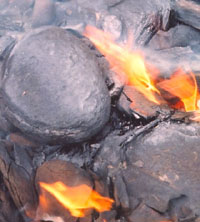
Photo from wikipedia
In this study, oils from various sources were subjected to pyrolysis conditions; that is, without oxidizer, as the samples were heated to 500 °C, and held at that temperature. The… Click to show full abstract
In this study, oils from various sources were subjected to pyrolysis conditions; that is, without oxidizer, as the samples were heated to 500 °C, and held at that temperature. The oils studied included: (1) heavy oil from Grassy Creek, Missouri; (2) oil from tar sands of Asphalt Ridge in Utah; (3) mid-continent oil shales of three formations (two of Chattanooga formation, Pennsylvanian (age) formation, and Woodford formation); and (4) a Colorado Piceance Basin shale. Differential scanning calorimetry (DSC) and thermogravimetric analysis (TGA) with either gas chromatography (GC) or mass spectrometry (MS) were used to quantify the produced gases evolved in the tests. Purge gases of helium, argon, and humid carbon dioxide were utilized. Larger scale pyrolysis tests were conducted in a tube furnace coupled to a MS and a GC. The results consistently showed that pyrolysis occurred between 300 °C and 500 °C, with the majority of gases being mainly hydrogen and light alkanes. This behavior was essentially consistent, regardless of the oil source.
Journal Title: Energies
Year Published: 2023
Link to full text (if available)
Share on Social Media: Sign Up to like & get
recommendations!